towing BUICK CENTURY 1994 Owners Manual
[x] Cancel search | Manufacturer: BUICK, Model Year: 1994, Model line: CENTURY, Model: BUICK CENTURY 1994Pages: 308, PDF Size: 16.3 MB
Page 79 of 308
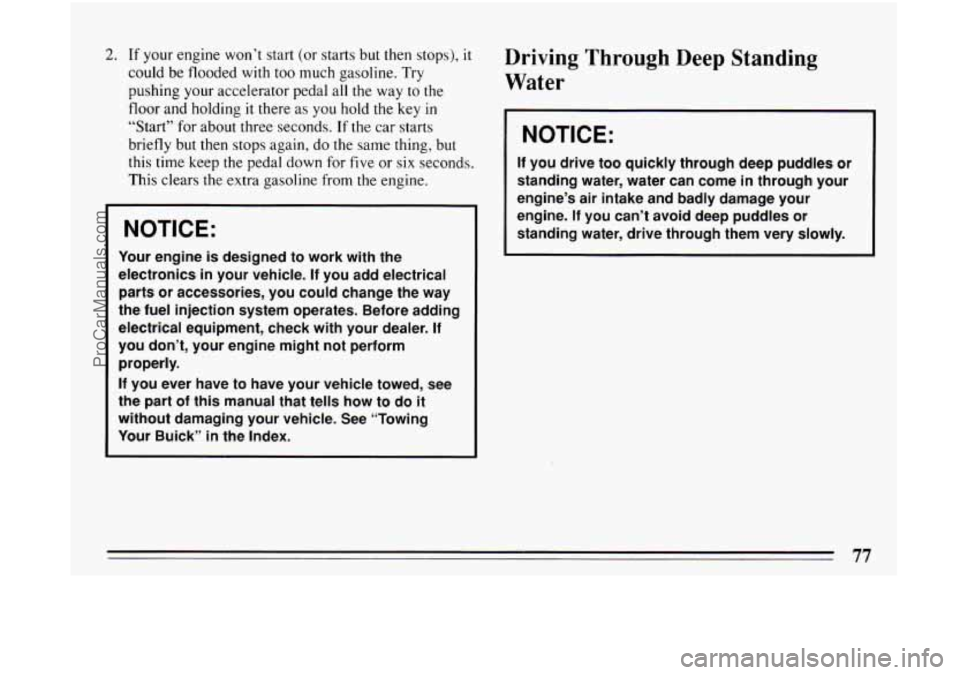
2. If your engine won’t start (or starts but then stops), it
could be flooded with too much gasoline. Try
pushing your accelerator pedal
all the way to the
floor and holding it there as you hold the key in
“Start” for about three seconds. If the car starts
briefly but then stops again, do the same thing, but
this time keep
the pedal down for five or six seconds.
This clears the extra gasoline from the engine.
I NOTICE:
Your engine is designed to work with the
electronics
in your vehicle. If you add electrical
parts or accessories, you could change the way
the fuel injection system operates. Before adding
electrical equipment, check with your dealer.
If
you don’t, your engine might not perform
properly.
If you ever have to have your vehicle towed, see
the part
of this manual that tells how to do it
without damaging your vehicle. See “Towing
Your Buick”
in the Index.
Driving Through Deep Standing
Water
I NOTICE:
If you drive too quickly through deep puddles or
standing water, water can come
in through your
engine’s air intake and badly damage your
engine.
If you can’t avoid deep puddles or
standing water, drive through them very slowly.
77
ProCarManuals.com
Page 83 of 308
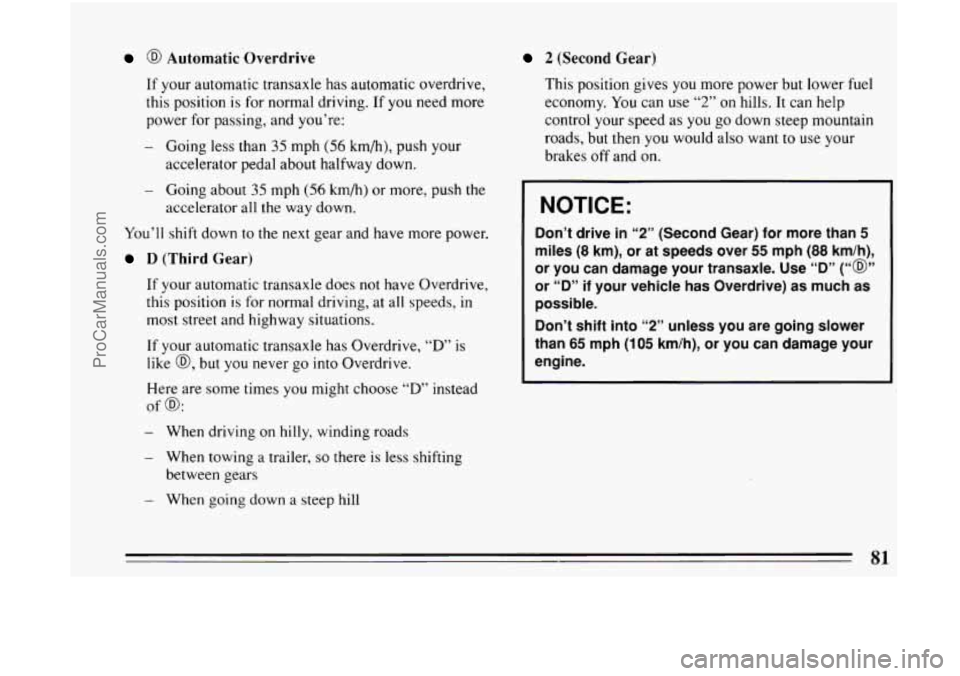
@ Automatic Overdrive
If your automatic transaxle has automatic overdrive,
this position is for normal driving.
If you need more
power for passing, and you’re:
- Going less than 35 mph (56 km/h), push your
accelerator pedal about halfway down.
accelerator all
the way down.
- Going about 35 mph (56 km/h) or more, push the
You’ll shift down to the next gear and have more power.
D (Third Gear)
If your automatic transaxle does not have Overdrive,
this position is for normal driving, at all speeds,
in
most street and highway situations.
If your automatic transaxle has Overdrive,
“D” is
like
@, but you never go into Overdrive.
Here are some times
you might choose “D” instead
of
03:
- When driving on hilly, winding roads
- When towing a trailer, so there is less shifting
- When going down a steep hill
between gears
2 (Second
Gear)
This position gives you more power but lower fuel
economy.
You can use “2” on hills. It can help
control your speed as you go down steep mountain
roads, but then
you would also want to use your
brakes off and
on.
I NOTICE:
Don’t drive in “2” (Second Gear) for more than 5
miles (8 km), or at speeds over 55 mph (88 km/h),
or you can damage your transaxle. Use “D”
(‘@’’
or “D” if your vehicle has Overdrive) as much as
possible.
Don’t shift into
“2” unless you are going slower
than
65 mph (1 05 km/h), or you can damage your
engine.
81
ProCarManuals.com
Page 85 of 308

I NOTICE:
Driving with the parking brake on can cause your
rear brakes
to overheat. You may have to replace
them, and you could also damage other parts
of
your vehicle.
If you are towing a trailer and are parking on any
hill:
See “Towing a Trailer” in the Index. That section
shows what to
do first to keep the trailer from moving.
Shifting Into ‘‘P” (Park)
A CAUTION:
Steering Column Shift Lever
1. Hold the brake pedal down with your right foot and
set the parking brake.
2. Move the shift lever into “P” (Park) position like
this:
0 Pull the lever toward you.
83
ProCarManuals.com
Page 89 of 308
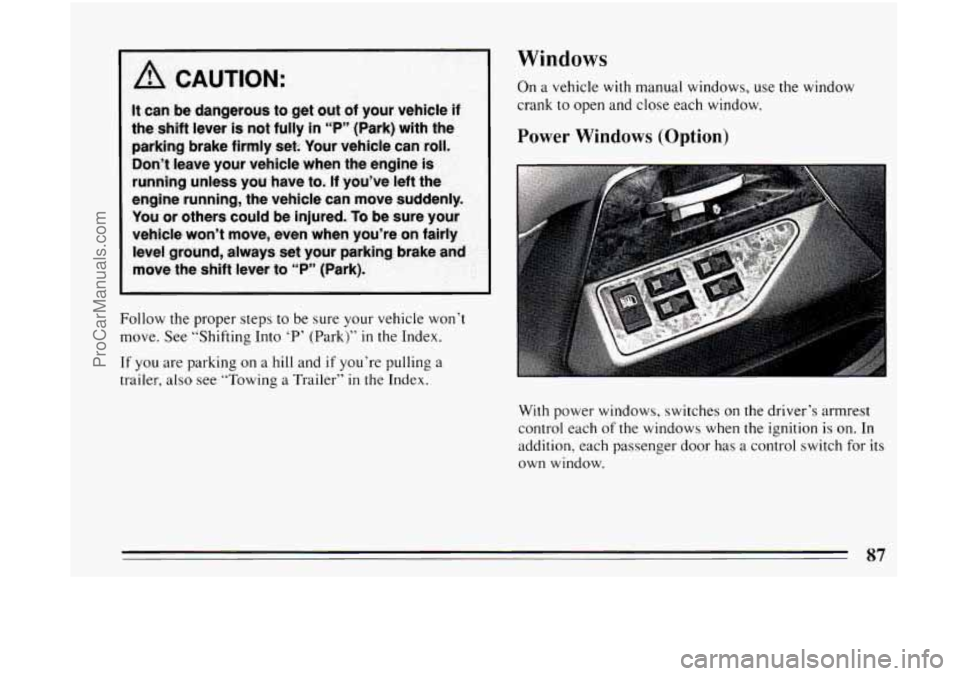
Follow the proper steps to be sure your vehicle won’t
move. See “Shifting Into
‘P’ (Park)” in the Index.
If you are parking on a hill and if you’re pulling a
trailer,
also see “Towing a Trailer” in the Index.
Windows
On a vehicle with manual windows, use the window
crank to open and close
each window.
Power Windows (Option)
With power windows, switches on the driver’s armrest
control each
of the windows when the ignition is on. In
addition, each passenger door has
a control switch for its
own window.
87
ProCarManuals.com
Page 115 of 308
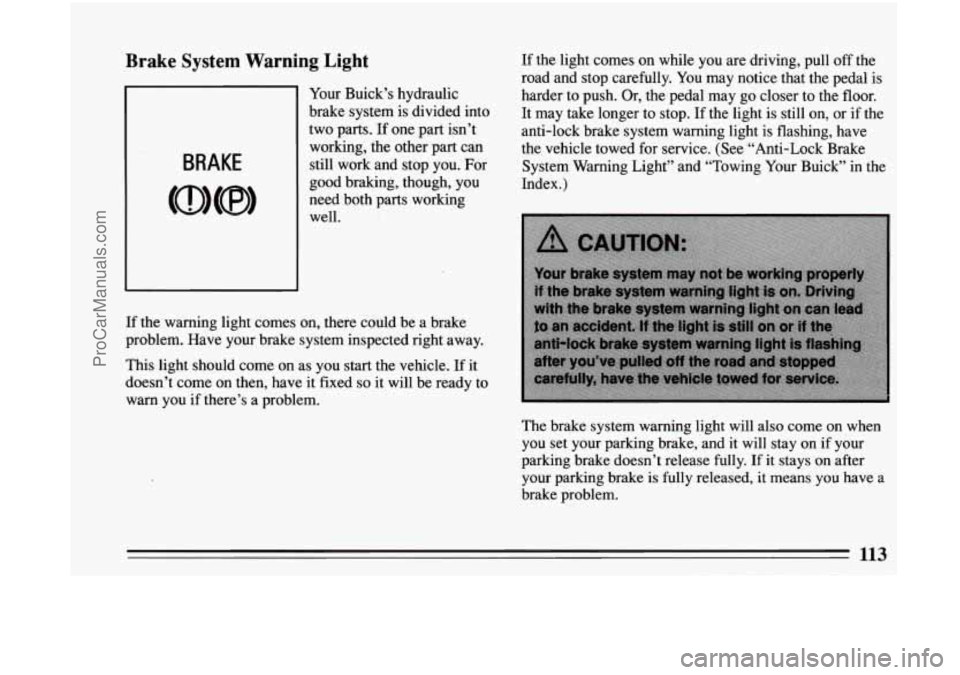
Brake System Warning Light
BRAKE
If the light comes on while you are driving, pull off the
road and stop carefully. You may notice that the pedal
is
Your Buick’s hydraulic harder to push. Or, the pedal may go closer to the floor.
brake system is divided into It may take longer to stop. If the light is still on, or if the
two parts. If one part isn’t
anti-lock brake system warning light is flashing, have
working, the other part can the vehicle towed for service. (See “Anti-Lock Brake
still work and stop you. For
good braking, though, you
need both parts working
well.
If the warning light comes on, there cou Ild
be a brake
problem. Have your brake system inspected right away. System
Warning Light” and “Towing Your Buick” in the
Index.)
This light should come on as you start the vehicle. If it
doesn’t come on then, have it fixed
so it will be ready to
warn you if there’s a problem.
The brake system warning light will also come on when
you set your parking brake, and it will stay on if your
parking brake doesn’t release fully. If it stays on after
your parking brake is fully released,
it means you have a
brake problem.
113
ProCarManuals.com
Page 116 of 308
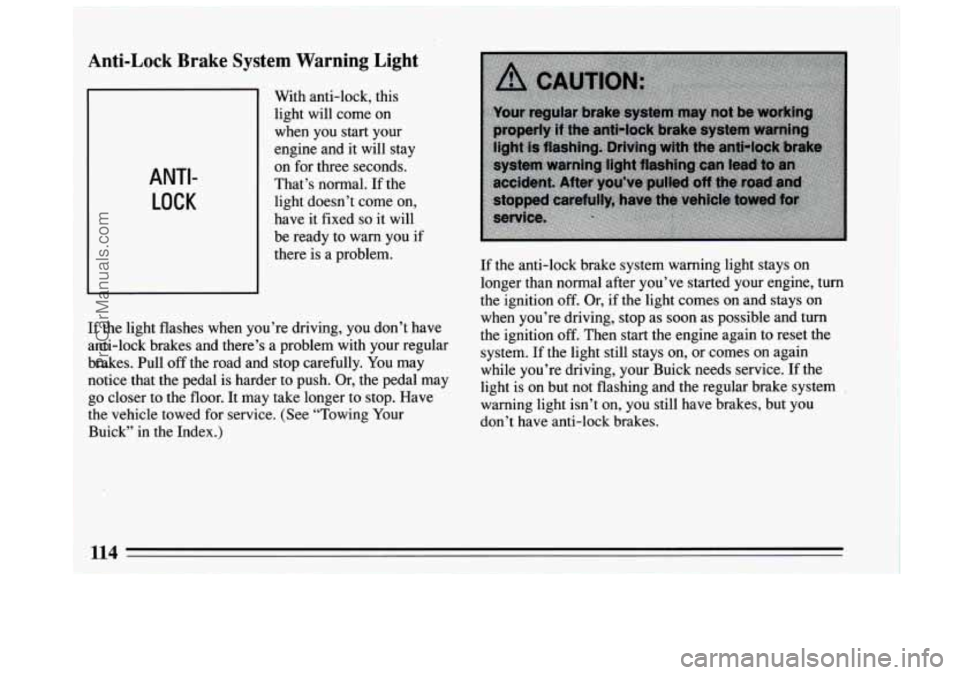
I
Anti-Lock Brake SJ
ANTI-
LOCK
‘S tern Warning’Light
With anti-lock, this
light will come on
when you start your
engine and it will stay
on for three seconds.
That’s normal.
If the
light doesn’t come on,
have it fixed
so it will
be ready to warn you if
there is a problem.
If the anti-lock brake system warning light stays on
longer than normal after you’ve started your engine, turn
the ignition off. Or, if the light comes on and stays on
when you’re driving, stop as soon as possible and turn
the ignition
off. Then start the engine again to reset the
system. If the light still stays on, or comes on again
while you’re driving, your Buick needs service.
If the
light is on but not flashing and the regular brake system
warning light isn’t on, you still have brakes, but you
don’t have anti-lock brakes.
If
the light flashes when you’re driving, you don’t have
anti-lock brakes and there’s a problem with your regular
brakes. Pull off the road and stop carefully. You may
notice that the pedal is harder to push. Or, the pedal may
go closer to the floor. It may take longer to stop. Have
the vehicle towed
for service. (See “Towing Your
Buick” in the Index.)
114 1
I
ProCarManuals.com
Page 141 of 308
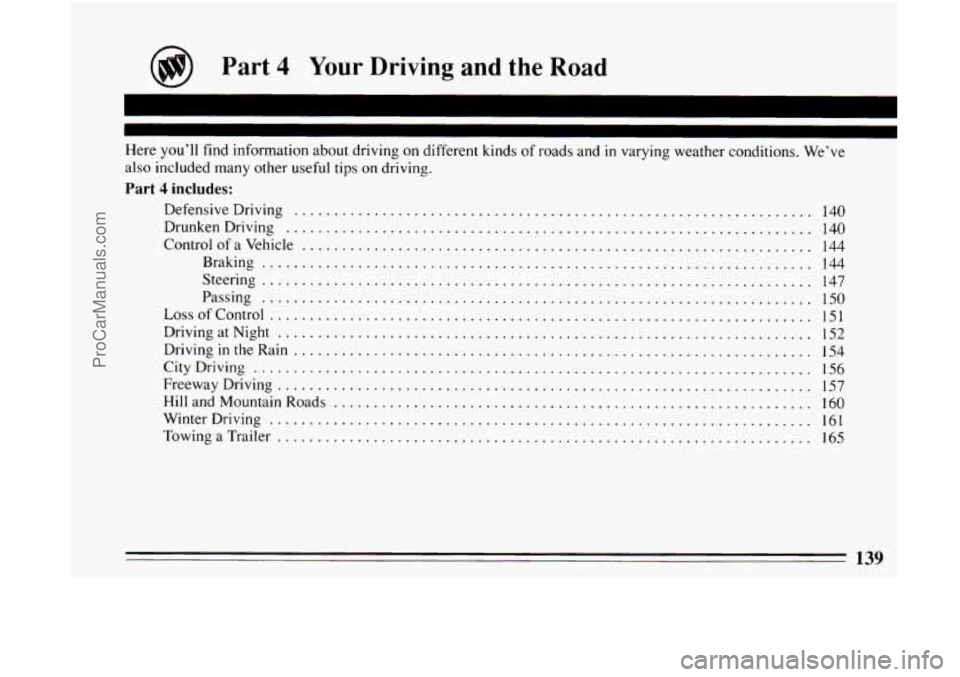
Part 4 Your Driving and the Road
Here you’ll find information about driving on different kinds of roads and in varying weather conditions . We’ve
also included many other useful tips on driving
.
Part 4 includes:
DefensiveDriving .................................................................
DrunkenDriving ..................................................................
Control of a Vehicle ................................................................
Braking .....................................................................
Steering .....................................................................
Passing .....................................................................
LossofControl ....................................................................
DrivingatNight ...................................................................
DrivingintheRain .................................................................
CityDriving ......................................................................
HillandMountainRoads ............................................................
WinterDriving ....................................................................
TowingaTrailer ...................................................................
FreewayDriving ...................................................................
140
140
144
144
147 150
151
152
154
156 157
160
161
165
139
ProCarManuals.com
Page 167 of 308
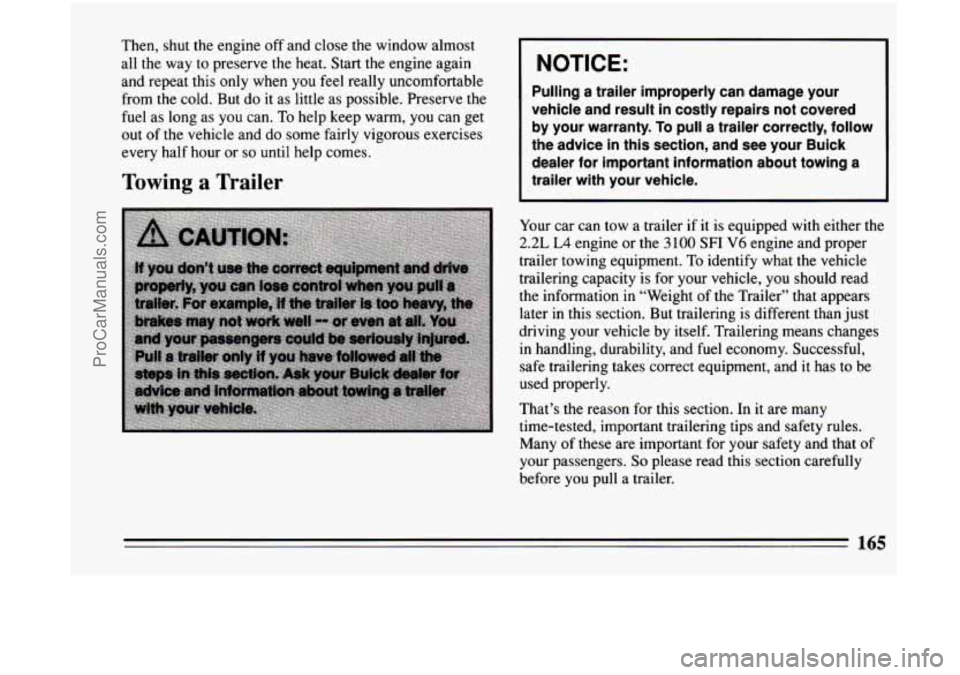
Then, shut the engine off and close the window almost
all the way to preserve the heat. Start the engine again
and repeat this only when you
feel really uncomfortable
from the cold. But do it as little as possible. Preserve the
fuel as long as
you can. To help keep warm, you can get
out
of the vehicle and do some fairly vigorous exercises
every half hour or
so until help comes.
Towing a Trailer
1 NOTICE:
Pulling a trailer improperly can damage your
vehicle and result in costly repairs not covered by your warranty.
To pull a trailer correctly, follow
the advice in this section, and see your Buick
dealer
for important information about towing a
trailer with your vehicle.
Your car can tow a trailer if it is equipped with either the
2.2L L4 engine or the 3 100 SF1 V6 engine and proper
trailer towing equipment.
To identify what the vehicle
trailering capacity
is for your vehicle, you should read
the information in “Weight
of the Trailer” that appears
later in this section. But trailering is different than just
driving your vehicle by itself. Trailering means changes
in handling, durability, and fuel economy. Successful,
safe trailering takes correct equipment, and it has
to be
used properly.
That’s the reason for this section. In
it are many
time-tested, important trailering tips and safety rules. Many of these are important for your safety and that
of
your passengers. So please read this section carefully
before
you pull a trailer.
165
ProCarManuals.com
Page 168 of 308
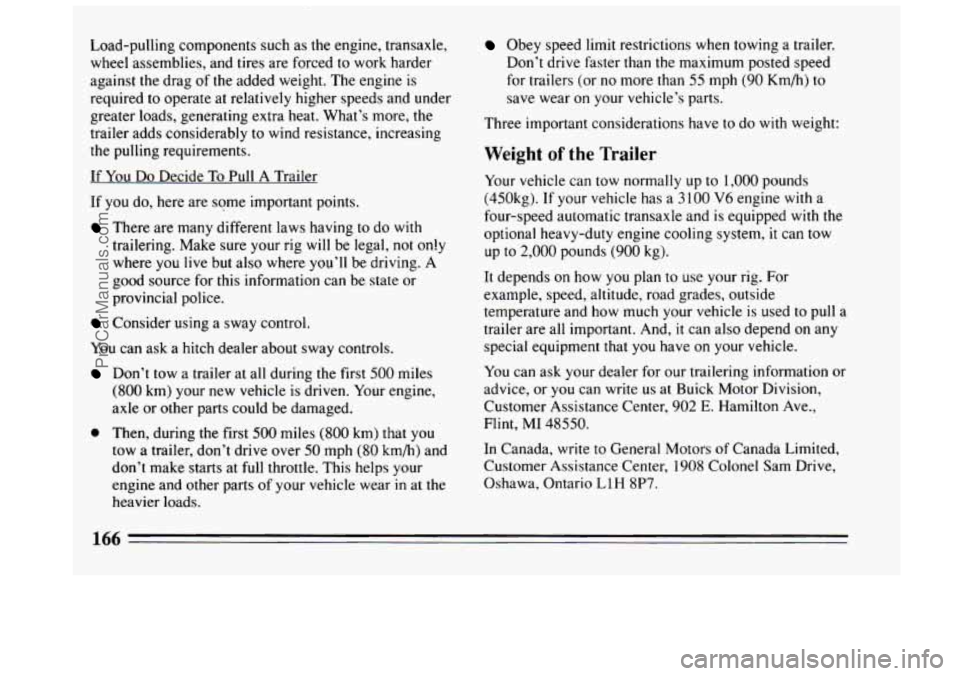
Load-pulling components such as the engine, transaxle,
wheel assemblies, and tires are forced
to work harder
against the drag of the added weight. The engine
is
required to operate at relatively higher speeds and under
greater loads, generating extra heat. What’s more, the
trailer adds considerably to wind resistance, increasing
the pulling requirements.
If
You Do Decide To Pull A Trailer
If you do, here are some important points.
There are many different laws having to do with
trailering. Make sure your rig will be legal, not on!y
where you live but also where you’ll be driving. A
good source for
this information can be state or
provincial police.
Consider using a sway control,
You can ask a hitch dealer about sway controls.
Don’t tow a trailer at all during the first 500 miles
(800 km) your new vehicle is driven. Your engine,
axle or other parts could be damaged.
0 Then, during the first 500 miles (800 km) that you
tow
a trailer, don’t drive over 50 mph (80 km/h) and
don’t make starts at full throttle. This helps your
engine and other parts
of your vehicle wear in at the
heavier loads.
Obey speed limit restrictions when towing a trailer.
Don’t drive faster than the maximum posted speed
for trailers (or no more than
55 mph (90 Km/h) to
save wear on your vehicle’s parts.
Three important considerations have to do
with weight:
Weight of the Trailer
Your vehicle can tow normally up to 1,000 pounds
(450kg). If your vehicle has a
3100 V6 engine with a
four-speed automatic transaxle and is equipped with the
optional heavy-duty engine cooling system,
it can tow
up to 2,000 pounds (900 kg).
It depends on how you plan to use your rig. For
example, speed, altitude, road grades, outside
temperature and how much your vehicle is used to pull a
trailer are all important. And,
it can also depend on any
special equipment that
you have on your vehicle.
You can ask your dealer for our trailering information or
advice, or
you can write us at Buick Motor Division,
Customer Assistance Center,
902 E. Hamilton Ave.,
Flint,
MI 48550.
In Canada, write to General Motors
of Canada Limited,
Customer Assistance Center,
1908 Colonel Sam Drive,
Oshawa, Ontario L1H
8P7.
166
ProCarManuals.com
Page 170 of 308
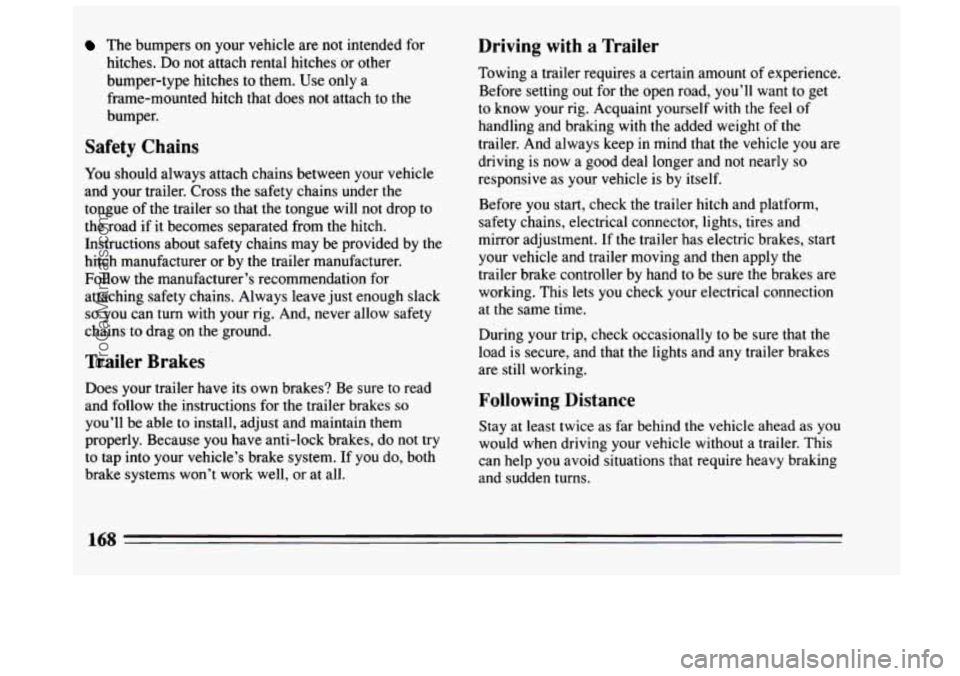
The bumpers on your vehicle are not intended for
hitches.
Do not attach rental hitches or other
bumper-type hitches to them. Use only a
frame-mounted hitch that does not attach to the
bumper.
Safety Chains
You should always attach chains between your vehicle
and your trailer. Cross the safety chains under the
tongue of the trailer
so that the tongue will not drop to
the road if it becomes separated from the hitch.
Instructions about safety chains may be provided by the
hitch manufacturer or by the trailer manufacturer.
Follow the manufacturer’s recommendation for
attaching safety chains. Always leave just enough slack
so you can turn with your rig. And, never allow safety
chains
to drag on the ground.
Trailer Brakes
Does your trailer have its own brakes? Be sure to read
and follow the instructions for the trailer brakes
so
you’ll be able to install, adjust and maintain them
properly. Because you have anti-lock brakes, do not try
to tap into your vehicle’s brake system. If you do, both
brake systems won’t work well, or at all.
Driving with a Trailer
Towing a trailer requires a certain amount of experience.
Before setting out for the open road, you’ll want to get
to know your rig. Acquaint yourself with the feel
of
handling and braking with the added weight of the
trailer. And always keep in mind that the vehicle you are
driving is now a good deal longer and not nearly
so
responsive as your vehicle is by itself.
Before
you start, check the trailer hitch and platform,
safety chains, electrical connector, lights, tires and
mirror adjustment. If the trailer has electric brakes, start
your vehicle and trailer moving and
then apply the
trailer brake controller by hand to be sure the brakes are
working. This lets
you check your electrical connection
at the same time.
During your trip, check occasionally to be sure that the
load is secure, and that the lights and any trailer brakes
are still working.
Following Distance
Stay at least twice as far behind the vehicle ahead as you
would when driving your vehicle without a trailer. This
can help
you avoid situations that require heavy braking
and sudden turns.
168
ProCarManuals.com